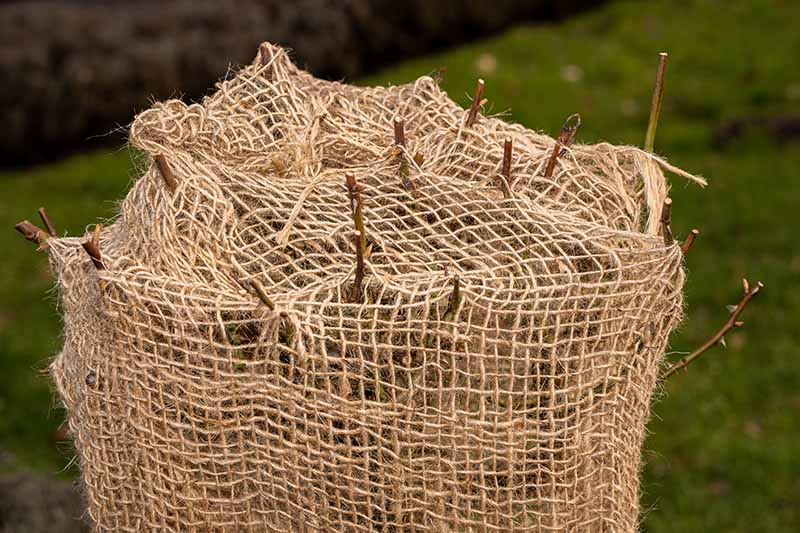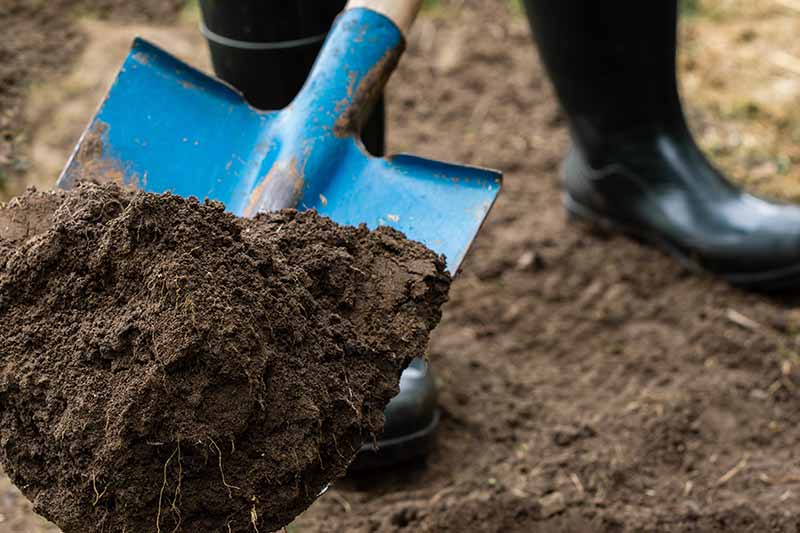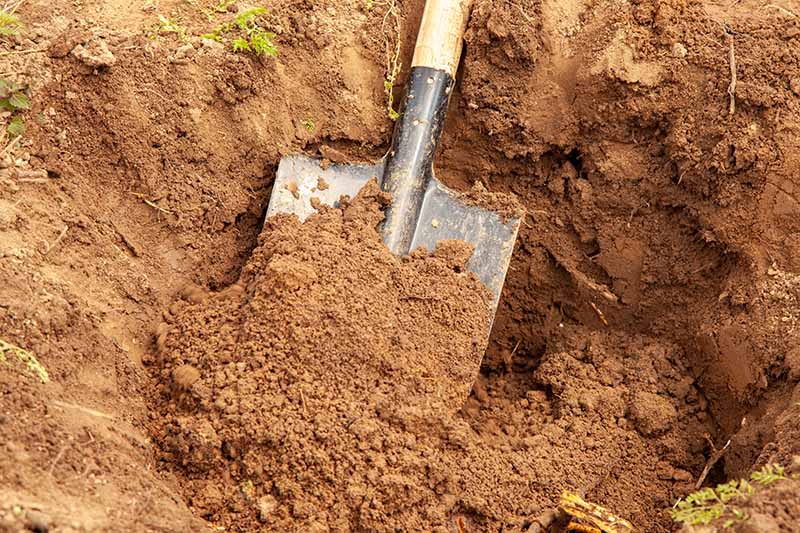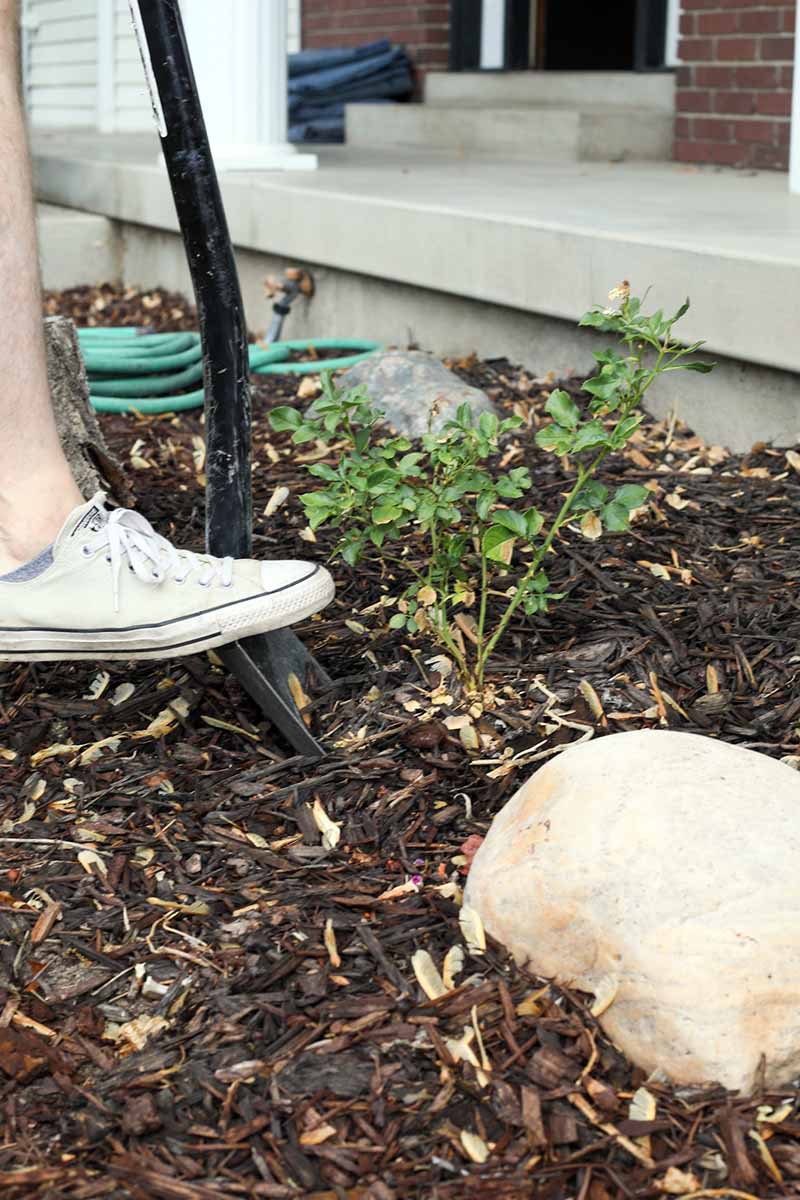Every time you walk down the sidewalk, that formerly petite rose you planted seems to reach out and grab you. Pruning can only go so far: It’s officially time to move that overgrown plant.
Or maybe your rose used to bloom so abundantly you could hardly see the leaves, but now it’s struggling just to stay alive. The solution might just be a new home.
I’ve talked to so many gardeners who express concern, believing that once a rose is in the ground, it’s a bad idea to move it. But that’s not true!
If your plant isn’t in the right place, it’s much better to put it somewhere else that’s more suitable than to leave it where it is, and most roses will be much better off in the long run.

We link to vendors to help you find relevant products. If you buy from one of our links, we may earn a commission.
Sure, the plant might be a bit stressed by the move, but don’t worry. If you complete the steps we describe below, it probably won’t even bat an eye. Or, it wouldn’t if it had eyes.
I once moved a rose that was in full bloom in the middle of summer, and it kept right on flowering like nothing had happened. On the off chance that the plant is impacted, it will likely only be for the short-term.
So, how do you do the job without killing the poor thing? Here’s what we’ll cover in this guide:
What You’ll Learn
A plant that needs constant pruning to keep it in a space that’s just too small for it will never live up to its full potential.
A rose bush that’s being drowned by soil with poor drainage, or shaded by a tree that has gotten too large, will struggle to survive. Moving it is the way to go.
Let’s get started.
When to Transplant
The best time to transplant roses is in the spring or fall, but if your plant is in a bad situation, it’s best to act swiftly, regardless of the time of year.
If your shrub is growing in soil that’s completely wrong for it, or with sun exposure that’s less than adequate, transplant it as soon as possible.

If you can wait for the perfect time, early spring is ideal, when it is still dormant but the soil can be worked. So is the fall, after the hips have formed, if your rose produces them.
In areas where the soil doesn’t freeze solid, you can move your dormant rose any time during the winter. A dormant plant will be less disturbed by a move than one that is actively growing.
A good rule of thumb for when to transplant in terms of weather is to remember these three qualities: cool, cloudy, rainy.
Your rose will experience less shock if you move it on a cool or cloudy day, or a day after it rains. You could even move it during a light drizzle, but let the ground dry out just a touch if you’ve had a deluge.
Because there is more moisture available and less drying sunlight and heat, cool, cloudy and post-rain days are ideal. The fact that you’ll probably be a lot less sweaty is just a bonus.
Prepare Your Rose Bush
To help ease the transition, a little preparation is in order. Prune the dormant plant back by half, or an actively growing plant back by a third.
We do this because we are inevitably reducing the plant’s root structure, so it won’t be able to support the same amount of foliage for a little while.

Be sure to remove any blossoms as well. We want it to focus on getting reestablished, not sending out flowers.
Having said that, if your plant is small – say, under two feet – you don’t have to trim it back. You can also leave a larger plant untrimmed if you don’t want to reduce its overall size.
But if you choose not to prune, you’ll need to be extra vigilant about keeping an eye on your transplant to monitor how it’s doing.
If it starts wilting, it’s telling you that it can’t support all of its foliage with its newly-reduced root system, since it’s unlikely that you dug up all of the roots in their entirety when you moved it.
You can try giving it water more frequently to see if that helps. If not, trim it back by a third.
If the plant isn’t dormant, give it a deep drink of water the day before you plan to move it.
Right before transplanting, wrap the plant in burlap, or use burlap strips or rope to gently tie the canes up and hold them together.
You can skip this step for anything that is fairly small, but any plant that is wider than two feet should be contained.
Trust me, this will make your life much easier and much less painful. This is especially important for ground cover roses.
And speaking of pain, don’t forget to wear protective gloves while you work!

If you’re moving a climbing type, you’ll need to trim about a third of the height off to make it more manageable. You might also want to enlist the help of a friend to support the height of the plant as you move it.
Or, be prepared to lay the plant on its side on a tarp and drag it along the ground to the transplanting area.
Make the New Hole
Before you start digging up the plant, make the new hole first. That way, your rose will spend as little time as possible with its roots exposed to the elements.

If you’ve never planted a rose bush before, it’s pretty similar to how you would go about planting any other woody shrub. Dig a hole that is at least twice as wide and as deep as the existing root ball.
“But I can’t see the roots,” I hear you thinking.
This is the point where we have to do a little bit of guesswork.
Consider the full stature of the shrub, and divide the total height by four and the total width by two.
For example, a plant that is about four feet tall and three feet wide will probably have a main root structure that is about 12 inches deep and 18 inches wide.
Roses tend to have shallow roots that grow out rather than down. Unless your plant is significantly larger or smaller than the dimensions described above, you can assume the main root structure is about this size.
For ground cover roses, switch the dimensions. Divide the total width by four and the height by two when calculating the size of the root ball. For climbing roses, use the width as your guide, and dig about two-thirds as deep as you dig wide.
Sometimes people suggest using the drip line (the spot where water drips off the canopy of a plant and onto the soil) as a guideline for the root width to indicate where you should start digging. You can certainly do this with roses too.
But you should dig just a little bit further out than the drip line, since rose roots tend to grow beyond that point. Measure how wide your circle is across the middle, and divide by two-thirds. That’s about how deep you should plan to dig.
When digging your hole, make it twice as wide as the calculated width of the roots, and a few inches deeper than your calculated depth.
So, for a four-foot by three-foot shrub rose, you should ideally dig a new hole that is about 14 inches deep and 36 inches wide.
However, a three-foot-wide hole might be a bit unrealistic, unless you’re looking for a really good workout or you have an excavator at your disposal.
Just go as wide as you can, and don’t worry about being exact. Most roses are pretty adaptable.

Mix some compost into the soil that you have removed from the hole, and put some of the mixed soil back into the base of the hole so that the plant will be sitting as high as it was previously.
Make a little cone of soil in the base of the hole for the roots to sit over.
For more tips on how to dig the perfect hole for your shrub, our guide to planting roses has all the information you need.
Dig Up the Plant
It’s time to pick that shovel back up and move your plant. You want to use a pointed or round digger to make the job easier. Then, start digging straight down.
You’re not trying to remove dirt, but rather, your aim here is to separate the root ball from the surrounding soil.
For a small rose that’s under a foot tall or so, all you’ll need to do is push the shovel down into the soil as deep as possible with your foot. Repeat this all the way around the perimeter.

Then, pick a spot where you have dug, insert the shovel, tilt the handle towards yourself, and pop the plant out.
For larger roses, push the shovel down and then wiggle it back and forth and side to side a little. Then, move the shovel over a little and repeat until you’ve gone around the perimeter.
If you encounter large roots or some strong resistance, move the shovel out a few inches and start digging down again.
If you have other plants growing nearby that also have large roots, you might need to take a garden saw or trimmers and just clip the roots rather than trying to find a root-free spot.
Try to dig up anything larger than a pinkie finger in diameter, and leave a few inches of space around the plant.
Lots of lateral roots will be left behind, but that’s okay. We’re just aiming to extract the bulk of the main root structure.
If you start digging and you find that the roots are much larger than you anticipated, stop where you are, and go make your new hole larger. Then come back and move your shovel out a few inches to make the perimeter wider so you can remove more of the roots.
Dig down as deep as you need to so that you are no longer hitting large, pinkie-width roots with your shovel. Continue digging down in a circle around the rose.
Remember, you’re creating a break where the plant will separate from the surrounding soil, not trying to dig the plant out just yet, so you shouldn’t have to remove much (if any) soil during this part of the process.
Once you have dug down all the way around, grab a garden fork and put it in one of the trenches that you have made.
Gently tilt the handle of the fork back toward your body, using leverage to move the root ball out of the hole. You might need to wiggle the fork back and forth and work it out.
If you have a friend who can do the same thing at the same time on the opposite side of the plant, all the better.
You can also use a shovel to do this. Just take care not to sever any large roots as you work the shovel underneath the plant.
As you are lifting, you may find some roots that resist. Rather than tugging and ripping the plant out of the soil, use clean pruners to clip away these roots at the deepest point you can reach.
Put Your Rose in the Ground
Ready to put that rose in its new place? If you wound up with a large ball of soil, put your dug-up plant on a tarp, and drag it over to its new location or ferry it over in a wheelbarrow. If the plant is a manageable size for you, just carry it to its new spot.
Gently loosen the soil at the base of the root ball to free up the roots. Then, spread those over the cone of soil that you made. This encourages the roots to grow out rather than binding up or growing straight down.
If you weren’t able to dig a hole large enough to contain the roots, you can trim some of the outliers off with a pair of secateurs so that the whole thing fits.
You’ll need to trim back some of the canes once you get it in the ground, however, so that the roots are able to support the top. Plan on trimming the rose to two-thirds of its original size.
Then, fill in around the plant with a mixture of the existing soil and well-rotted compost. Once you’ve filled the hole about two-thirds of the way, soak it with water to help settle the soil. Fill the hole the rest of the way and water again.
Remove any burlap or rope that you used, and trim the plant back if necessary.
Keep a close eye on your plant, and plan to give it more water than you would normally. Start by providing the same amount of water as you have in the past, but if you notice any wilting, increase the amount by half.
If you moved it during the summer, you might even want to give the foliage a good misting in the morning as well.
Don’t add any fertilizer until you see new growth emerge.
Give Your Rose the Right Home
It might seem like a lot of work to move a plant from one spot to another, but you’ll be so much happier once your rose is in a better location, and so will your plant.

If you have any trouble with the process, or you aren’t sure if you should move your rose or leave it where it is, leave us a comment below and we’ll see if we can help.
Hopefully, this guide helped you to move your rose to the right spot. If so, you might want to expand your rose-growing knowledge with one of our other guides, starting with these:



Thank you so much for all your info, this has been very helpful. We are planning to move a rose this weekend. We live in British Columbia, Canada. I would like to plant lavender on each side of the rose. Can I do this, and will the rose survive? The location is sun most of the day. Thank you so much.
Sure, this is a good time of year to transplant and the rose should be fine if you follow the steps described above. Roses and lavender do well together, but keep in mind that lavender prefers slightly drier soil than roses. That means you can either leave several feet between the plants and give the rose a little extra moisture, or just water to suit the rose. Most lavender do fine with a little extra water.
This is very helpful. I have a very old rose (more than 25 years) that probably is just the root stock of a previously grafted rose. Nevertheless, I actually like it’s exuberance and want to keep it. But, it is next to an overgrown laurel and not getting enough sun so it is reaching out far to get to it. It occurred to me that maybe I could move it to a sunnier spot just a five feet away. This has been a weird winter, though, and it’s started to bud (?) a little. I was going to give it… Read more »
Hi Kelly, feel free to move it. Now is a great time to change the position of a rose bush if it isn’t doing well. Sounds like your rose would be much happier in a different spot. Definitely give it a good prune before moving, as well. A shrub rose can be pruned to about a third of its existing size and most other roses can be pruned to about half before a big move.
Thank you! I pruned it on Sunday and we moved it today. The weather has been warm recently and it was starting to get little buds. It was about 50 degrees and overcast. It’s in a much better spot now – more sun. I built a nice copper arbor for it and I’ll place that soon. Fingers crossed that the move wasn’t too traumatic. We had to cut some roots, but we tried to get most of them (one is about an arm’s thickness!).
Sounds like your rose has a pretty healthy root system! It might be a bit stunted this year, so just be sure to provide it with plenty of water and fertilizer to support it as it becomes re-established. Don’t feed it until you see new growth emerging, though.
It will likely need more water than it did before since it is in a sunnier spot. Good luck, I’m sure it will be perfectly happy in no time!
I hope it’s okay. It’s going to be really cold (below 30) at night this week. I covered the base of the bush with burlap and it’s been well watered. Fingers crossed that is stays strong and hangs in there. Already I love it’s new location and I hope it does too!
I live in Indiana and I have a very large rose. I would like to move it and split it up into 3 or 4 separate plants… is this a good time of year to do that?
Ideally, you should do any sort of dividing or heavy pruning in the winter or early spring, but that’s primarily so you won’t impact the coming blossoms. If you don’t mind the possibility that you might not see any flowers for a while, feel free to move and split away.
Hi Kristine, thanks so much for your comprehensive guide on moving roses, it will be great to move now that I am armed with your instructions. I will definitely read your other stuff too. It was interesting to read that you moved from Utah and ended up in forest area! I’m in Nottingham, England. Thanks again for all your help.
Thank you for all the information! I just transplanted about 14 rose bushes from someone that didn’t want them into my yard and they are in shock. I haven’t pruned them because I don’t want to stress them out even more, but I think I might in the next day or so depending on how they are looking. How long do they stay in shock and would you suggest pruning back right away? Also, I only used the original soil in my yard and didn’t add any compost or other soil, so it doesn’t feel like it needs to grow… Read more »
Hi Georgina – don’t worry too much. So long as they have a healthy root structure they should be able to recover next year. Having said that, absolutely give them a prune. Because the roots have been damaged by transplanting, they can’t support as large a plant. Reducing the above-ground parts by a third will help the plant recover in the long term.
Mulch is a good idea, but don’t worry about feeding or anything at this point. In the spring, feed and top dress with some well-rotted compost.
What is the name of the red rose bush the has written below it – “Be sure to remove any blossoms as well. We want it to focus on getting reestablished, not sending out flowers.”?
It is beautiful and I would love to find one like it.
Hi Sharon, I’m sorry, I don’t know exactly which rose that is. But if you want to recreate the look, plant ‘Grand Champion.’ It’s an incredible rose that looks very similar to that, and is disease and pest-resistant, drought-tolerant, and thrives in hot and cold temperatures that cause other roses to struggle. It’s available from Fast Growing Trees.
Your article is really informative- thank you. We have to move some roses now in Colorado and it’s still pretty cold. Because our ground is frozen can we put the roses in a 5gallon bucket until it warms up a bit? Or do you have a suggestion to keep them for a month or so until we can re-plant them?
The beloved beauties have to be moved before the property is sold.
Hi Christy, I’d definitely recommend that you keep them in a bucket or other container until you can break into the ground and do some amending. The plants will be fine hanging out in a container since they’re dormant. Just put them in a protected area because they’ll be more susceptible to the effects of thawing and freezing.
I have a lot of weeds around my roses. Weeds like creeping charley. Should I try to remove all of the dirt around the roots in order to remove all of the weed roots?
Hi Mike, you definitely want to get all the roots out, so if you need to take up a little dirt, do it. Just try to knock as much back onto the ground as you can. If you’re still low, purchase some garden soil and fill the area back up. You don’t need to dig up a margin around the roots, though. Just get the roots.
i live in colorado. my sister planted a rose bush in my back yard many years ago. no one can see it and its beautiful!! i want to transplant to the front yard but am really freaked out about doing it. my sister passed away years ago and i want to have it where people can see it. i will have to wait until next year since i waited too long. It makes me think of her. I want to do it right. your advice was so helpful.
Hi Beth, I’m sorry to hear about your loss and I totally understand how important our plants can be in keeping the memory of our loved ones alive.
I would suggest taking a cutting this year before moving your rose. That way, if something happens, you’ll still have the plant. That said, I’m sure it will be fine. Roses transplant readily. Best of luck!
Hi, I have just transplanted some roses from someone on Facebook. I am in Australia, so it has just turned to spring. I made the mistake of putting fertiliser on them thinking this will prevent them from going into shock. I’m just reading your article though, what can happen now I’ve used fertiliser when they are freshly transplanted?
Thank you for your great article!
Hi Lynn, don’t worry, it’s not the end of the world. Fertilizer can encourage leaf growth when we want the plant to focus on growing roots right now. It can also cause the plant to grow when it’s still experiencing transplant shock, which we don’t want because it will further weaken the plant. So long as you keep them supported with appropriate water, they should be fine.